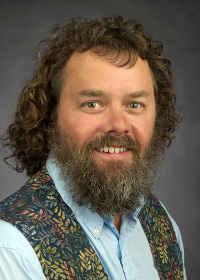Faculty
Professors | Lecturers | Affiliate | Postdocs | Emeritus

Professors

Timothy S. Magnuson, Ph.D.
Professor Microbiology
Research
Microbial Physiology and Biochemistry and Environmental Microbiology.
Teaching
BIOL 4433/5533 - Microbial Physiology Lecture & Laboratory
BIOL 4473/5573 - Applied and Environmental Microbiology Lecture & Laboratory
BIOL 6633 - Advanced Microbial Physiology
BIOL 4471/5571 - Biological Imaging
BIOL 4481 - Field & Laboratory Mycology
Biographical Sketch
Professor Magnuson received his B.S. in Biochemistry at the University of Minnesota, and M.S. and Ph.D. degrees in Bacteriology at the University of Idaho, under the guidance of Professor Don L. Crawford. The dissertation research focused on biomass conversion, more specifically the bacterial enzymes of lignocellulose degradation. His research focus changed abruptly upon joining Professor Derek Lovley’s group at the University of Massachusetts as a Postdoctoral Scientist investigating the biochemistry of iron respiration in Geobacter, a versatile and extremely interesting bacterium. That experience led to a Postdoctoral position with Dr. Gill Geesey of Montana State University, where he developed novel methods for investigating microbe-mineral interactions. Dr. Magnuson joined the Faculty at Idaho State University in 2001 and has developed a suite of collaborative projects with scientists at ISU, Montana State University, Idaho National Laboratory, Utah State University, and NASA Ames Research Center.
The Magnuson Microbiology Group investigates how microbes survive and thrive in exotic environments, using even more exotic substrates. While our work is foundational, we believe that this knowledge will help in developing new technologies and approaches to solve humankind's challenges of clean energy and a clean environment. Funding from the Department of Energy, National Science Foundation, and NASA have enabled their explorations, and they use research as a teaching and training platform for undergraduate, graduate, and postdoctoral students.
Education
1996, Ph.D. Bacteriology, University of Idaho, Moscow, ID
1991, M.S. Bacteriology, University of Idaho, Moscow, ID
1987, B.S. Biochemistry, University of Minnesota, Minneapolis, MN
1999-2000, Postdoctoral fellow, Microbial physiology, Montana State University, Bozeman, MT
1996-1999, Postdoctoral fellow, Microbial physiology, University of Massachusetts, Amherst, MA
Selected Publications
Ray, A.E., S.A. Connon, A.L. Neal, Y. Fujita, D.E. Cummings, J. C. Ingram, and T.S. Magnuson. 2018. Metal Transformation by a Novel Pelosinus Isolate from a Subsurface Environment. Frontiers Microbiol. 17 August 2018 | https://doi.org/10.3389/fmicb.2018.01689.
Ledbetter, R.N., A.M. Garcia Costas, C.E. Lubner, D.W. Mulder, M. Tokmina-Lukaszewska, J.H. Artz, A. Patterson, T.S. Magnuson, Z.J. Jay, H.D. Duan, J. Miller, M.H. Plunkett, J.P. Hoben, B.M. Barney, R.P. Carlson, A.F. Miller, B. Bothner, P.W. King, J.W. Peters, and L.C. Seefeldt. 2017. The Electron Bifurcating FixABCX Protein Complex from Azotobacter vinelandii: Generation of Low-Potential Reducing Equivalents for Nitrogenase Catalysis. Biochemistry 56(32):4177-4190. doi: 10.1021/acs.biochem.7b00389.
Schwabedissen, S. G., K. A. Lohse, S. C. Reed, , K. A. Aho, and T. S. Magnuson. 2017. Limits of Nitrogen Fixation by Biological Soil Crusts in a Cold Desert Sagebrush Steppe. Biogeochemistry 134: 57-76.
Blay, E.S., S. G. Schwabedissen, T. S. Magnuson, K.A. Aho, P.P. Sheridan, and K.A. Lohse. 2017. Variation in Biological Soil Crust Bacterial Abundance and Diversity as a Function of Climate in Cold Steppe Ecosystems in the Intermountain West, USA. Microb. Ecol. 74: 691-700.
Magnuson, T.S., and R.N. Ledbetter. 2016. Experimental Geomicrobiology: From Field to Laboratory. In Manual of Environmental Microbiology, 4th Edition. American Society for Microbiology Press. (Invited Book Chapter).
Brown, S.D., S.M. Utturkar, T.S. Magnuson, A.E. Ray, F.L. Poole, W.A. Lancaster, M.P. Thorgersen, M.W. Adams, D.A. Elias. Complete Genome Sequence of Pelosinus sp. Strain UFO1 Assembled Using Single-Molecule Real-Time DNA Sequencing Technology. Genome Announc. 2014 Sep 4;2(5).
